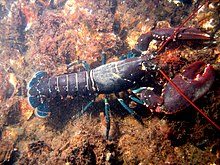
Homarus gammarus

Homarus gammarus, known as the European lobster or common lobster, is a species of clawed lobster from the eastern Atlantic Ocean, Mediterranean Sea and parts of the Black Sea. It is closely related to the American lobster, H. americanus. It may grow to a length of 60 cm (24 in) and a mass of 6 kilograms (13 lb), and bears a conspicuous pair of claws. In life the lobsters are blue, only becoming 'lobster red' on cooking. Mating occurs in the summer, producing eggs which are carried by the females for up to a year before hatching into planktonic larvae. Homarus gammarus is a highly esteemed food, and is widely caught using lobster pots, mostly around the British Isles. Homarus gammarus is a large crustacean, with a body length up to 60 centimetres (24 in) and weighing up to 5–6 kilograms (11–13 lb), although the lobsters caught in lobster pots are usually 23–38 cm (9–15 in) long and weigh 0.7–2.2 kg (1.5–4.9 lb). Like other crustaceans, lobsters have a hard exoskeleton which they must shed in order to grow, in a process called ecdysis (molting). This may occur several times a year for young lobsters, but decreases to once every 1–2 years for larger animals. The first pair of pereiopods is armed with a large, asymmetrical pair of feet. The larger one is the 'crusher', and has rounded nodules used for crushing prey; the other is the 'cutter', which has sharp inner edges, and is used for holding or tearing the prey. Usually, the left claw is the crusher, and the right is the cutter. The exoskeleton is generally blue above, with spots that coalesce, and yellow below. The red colour associated with lobsters only appears after cooking. This occurs because, in life, the red pigment astaxanthin is bound to a protein complex, but the complex is broken up by the heat of cooking, releasing the red pigment. The closest relative of H. gammarus is the American lobster, Homarus americanus. The two species are very similar, and can be crossed artificially, although hybrids are unlikely to occur in the wild since their ranges do not overlap. The two species can be distinguished by a number of characteristics: Female H. gammarus reach sexual maturity when they have grown to a carapace length of 80–85 millimetres (3.1–3.3 in), whereas males mature at a slightly smaller size. Mating typically occurs in summer between a recently moulted female, whose shell is therefore soft, and a hard-shelled male. The female carries the eggs for up to 12 months, depending on the temperature, attached to her pleopods. Females carrying eggs are said to be 'berried' and can be found throughout the year. The eggs hatch at night, and the larvae swim to the water surface where they drift with the ocean currents, preying on zooplankton. This stage involves three moults and lasts for 15–35 days. After the third moult, the juvenile takes on a form closer to the adult, and adopts a benthic lifestyle. The juveniles are rarely seen in the wild, and are poorly known, although they are known to be capable of digging extensive burrows. It is estimated that only 1 larva in every 20,000 survives to the benthic phase. When they reach a carapace length of 15 mm (0.59 in), the juveniles leave their burrows and start their adult lives. Homarus gammarus is found across the north-eastern Atlantic Ocean from northern Norway to the Azores and Morocco, not including the Baltic Sea. It is also present in most of the Mediterranean Sea, only missing from the section east of Crete, and along only the north-west coast of the Black Sea. The northernmost populations are found in the Norwegian fjords Tysfjorden and Nordfolda, inside the Arctic Circle.
